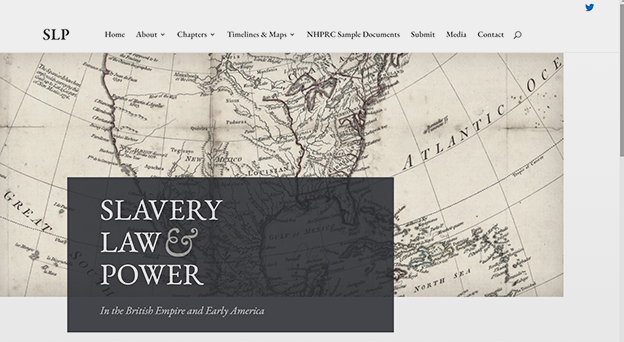
The presence of enslaved persons in the British parts of North America started long before some of the Founding Fathers owned slaves. Where many scholarly projects only take up the American view emphasising developments just before and during the 19th century, focus on the British side of this history is certainly welcome. Holly Brewer (University of Maryland, College Park) is director and lead editor of the project Slavery, Law & Power in the British Empire and Early America (SLP), and her team consists primarily of PhD students.

The various timelines and maps make the website graphically attractive, and it even includes a game titled ›Age of Empire‹ to raise awareness of the limitations and bias of maps. While the concise selection on literature for the bibliography is well thought out, it is unfortunately limited to just English-language publications. The section containing additional resources offers the reader access to a fine selection of digital projects. The palaeography is not neglected here, and several projects concerning the 19th century are also presented.
I am somewhat mystified, however, by the lack of introductions focusing on the key topics of the the SLP website: slavery, law and power in the early Americas. The three main themes are interconnected in many ways, yet no attempt is made to give due weight to all three. The ›Chapters‹ section is arranged in a rigid chronological order structured according to external political developments. A singular framework to put things into perspec|tive is rather meagre. Individual kings, Cromwell, the English parliament and major trading companies rightly so belong to the usual subjects when discussing the threefold core of the SLP project. However, the role of other European countries competing with the British Empire after 1600 is left completely in the dark.
Missing the chance to discuss key themes in greater depth mars the conceptual quality of this project. Not even the Atlantic triangle of trade is deemed worth mentioning. In the section on the Spanish empire from 1350 to 1550, entitled ›Antecedents‹, and duly marked as »under construction«, the Leyes de Burgos and the Leyes de Indias are conspicuously absent.
At the moment the SLP website is more or less an empty shell – one with several partially redeeming features such as the timelines, maps, the map game and the array of additional online resources. I will look here in some detail at a few elements connected with legal matters. The edition of the Barbados Slave Code (1661–1667) is quite useful, including not only the text but also images of the earliest archival record held at The National Archives, Kew, references to original sources and scholarly literature, and also a link to a separate digital library with document images for completed editions. As of right now, only a handful of editions are actually available. Some placeholders are not particularly well chosen: the Haitian declaration of independence (1804) is presented in English.
Having expressed my reservations and critical remarks, it is necessary to look at the exact aims and potential audience of the SLP project. The project team wants to bring together sources from many contexts into an open access format to shed light on the parallel development of democratic structures and the rise of the early modern slave trade within the British Empire. The project aims to help scholars easily access – without paywalls – a range of original sources concerning ongoing debates about law, slavery and power. However, the project team does not seem to be aware of the necessity for a systematic approach to using legal resources. Even in the section with additional resources, subjects such as Parliament, statutes and English legislation do not figure among the resources. How can one proceed to document vital debates without using resources on English parliamentary history? How can one present a solid documentary base without realising the difficulties of obtaining the relevant statutes? Let us mention just one example of a resource directly bearing on slavery, law and power: John Levin’s The Statutes Project, https://statutes.org.uk/site, which also includes among its online sources legislation for British overseas territories. Of course there should be space for a purely historical approach to matters surrounding slavery and its grim history, but for the SLP project it is counterproductive to omit legal history as an appropriate focus and vital research discipline. To rephrase the title of a recent lecture, law is both a tool and a problem. The absence of questions to be addressed within the context of the SLP project seems to be a sign of inadequate reflection and preparation.
Slavery, Law & Power is a very promising title. It will no doubt be useful to eventually have modern editions of a number of key sources assembled on a website that includes images of the original sources. It appears that the project team aspires to make a contribution to digital public history, yet even this very discipline goes unmentioned. The framework of the SLP project might be technically sound, but at the conceptual level its implications and limits have been given insufficient consideration. Questions and problems are not clearly articulated on the SLP website. Holly Brewer’s previous publications and projects have received praise, but the SLP project seems to either still be in its infancy after its official launch on 15 February 2022, or somehow it does not live up to its own aim, which suffers from a lack of concrete steps and goals, and from the absence of a clear conceptual framework. Since many other projects have focused on the actual practice of the slave trade and the lives of enslaved persons, it is surely a good idea to examine the political discourse, developments in government and the uses of legislation. As it stands right now, the SLP project still needs a great deal of work if it intends to fulfil the lofty goals it set out.
* Slavery, Law & Power in the British Empire and Early America, https://slaverylawpower.org/ (last visited 30 April 2022)